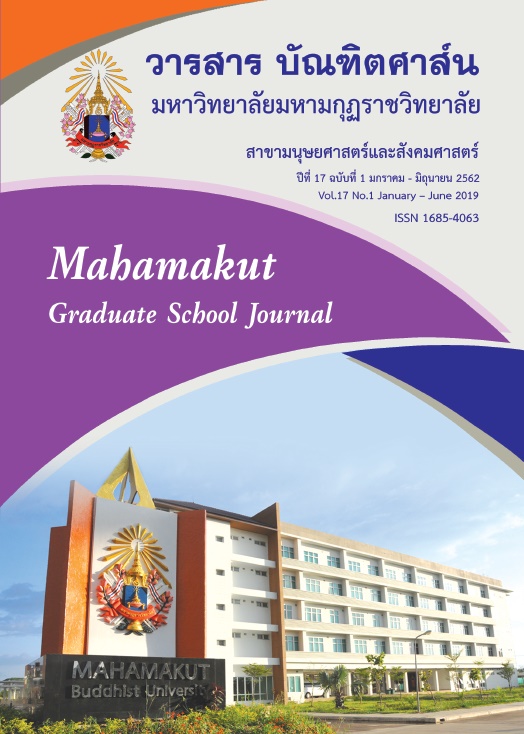รูปแบบความสัมพันธ์เชิงสาเหตุพฤติกรรมการบอกต่อ แบบปากต่อปากในการเลือกซื้ออาหารสัตว์เลี้ยง ผ่านเฟซบุ๊กของผู้บริโภค ในเขตกรุงเทพมหานครและปริมณฑล
คำสำคัญ:
อาหารสัตว์เลี้ยง, พฤติกรรม, การบอกต่อ แบบปากต่อปาก, เฟซบุ๊ก, โมเดลสมการโครงสร้างบทคัดย่อ
ปัจจุบันสินค้าอาหารสัตว์เลี้ยงกำ ลังเป็นที่นิยมเป็นอย่างมาก เนื่องจากผู้บริโภครักและใส่ใจสัตว์เลี้ยงมากขึ้น งานวิจัยนี้มีวัตถุประสงค์เพื่อพัฒนารูปแบบความสัมพันธ์เชิงสาเหตุพฤติกรรมการบอกต่อแบบปากต่อปากในการเลือกซื้ออาหารสัตว์เลี้ยงผ่านเฟซบุ๊กของผู้บริโภคในเขตกรุงเทพมหานครและปริมณฑลและเพื่อตรวจสอบความสอดคล้องของโมเดลความสัมพันธ์เชิงสาเหตุที่พัฒนาขึ้นกับข้อมูลเชิงประจักษ์ จากผู้ตอบแบบสอบถามจำนวนทั้งสิ้น 400 คน ได้มาโดยการสุ่มตัวอย่างแบบสะดวก จากผู้ที่มีประสบการณ์ซื้ออาหารสัตว์เลี้ยงผ่านเฟซบุ๊ก เครื่องมือที่ใช้ในการเก็บรวบรวมข้อมูลได้แก่ แบบสอบถามออนไลน์แบบมาตรประมาณค่า7 ระดับ ใช้เทคนิคการวิเคราะห์โมเดลสมการโครงสร้างโดยใช้โปรแกรมสำเร็จรูป โมเดลวิจัยในภาพรวมประกอบด้วย 6 องค์ประกอบ ได้แก่ 1. ด้านคุณค่าตราสินค้า 2. ด้านความคุ้มค่าของตราสินค้า 3. ด้านความสัมพันธ์ 4. ด้านความภักดีของลูกค้า 5. ด้านความตั้งใจซื้อ6. ด้านพฤติกรรมการบอกต่อแบบปากต่อปากผลการวิเคราะห์โมเดลความสัมพันธ์เชิงสาเหตุพบว่า โมเดลมีความสอดคล้องกับข้อมูลเชิงประจักษ์เป็นอย่างดี โดยมีค่าสถิติ ไค-สแควร์ ( ) = 572.135,องศาอิสระ (df) = 381, CMIN/df = 1.50, GFI = 0.92,AGFI = 0.90, CFI = 0.98, SRMR = 0.04, RMSEA =0.03 และค่าสัมประสิทธิ์การพยากรณ์เท่ากับ 0.90แสดงว่าตัวแปรในโมเดลสามารถอธิบายความแปรปรวนพฤติกรรมการบอกต่อแบบปากต่อปากในการเลือกซื้ออาหารสัตว์เลี้ยงผ่านเฟซบุ๊กได้ร้อยละ 90 สรุปได้ว่าพฤติกรรมการบอกต่อแบบปากต่อปากในการเลือกซื้ออาหารสัตว์เลี้ยงผ่านเฟซบุ๊กได้รับอิทธิพลทางตรงจากด้านความภักดีของลูกค้าและด้านความตั้งใจซื้อพบปัจจัยที่มีอิทธิพลทางอ้อมต่อพฤติกรรมการบอกต่อแบบปากต่อปากในการเลือกซื้ออาหารสัตว์เลี้ยงผ่านเฟซบุ๊กมากที่สุด ได้แก่ ด้านความสัมพันธ์ ผลจากการวิจัยในครั้งนี้สามารถใช้เป็นแนวทางในการพัฒนา และวางกลยุทธ์ทางการตลาดของ เฟซบุ๊กเพื่อตอบสนองความต้องการของกลุ่มลูกค้าได้ตรงกลุ่มเป้าหมาย
เอกสารอ้างอิง
2.นีลเส็นเผยคนไทย 97 ร้อยละ ชอบลองของใหม่. (2556). สืบค้นจาก http://www.bangkokbiznews.com/news/detail/489193
3.นงลักษณ์ วิรัชชัย. (2542). โมเดลลิสเรล: สถิติวิเคราะห์สำหรับการวิจัย (พิมพ์ครั้งที่ 3). กรุงเทพฯ: โรงพิมพ์แห่งจุฬาลงกรณ์มหาวิทยาลัย.
4.พิศุทธิ์ อุปถัมภ์. (2556). ความไว้วางใจและลักษณะธุรกิจผ่านสื่อสังคมออนไลน์ส่งผลต่อความตั้งใจซื้อสินค้าผ่านสื่อสังคมออนไลน์. บริหารธุรกิจมหาบัณฑิต, มหาวิทยาลัยกรุงเทพ.
5.สำนักงานพัฒนาธุรกรรมทางอิเล็กทรอนิกส์. (2560). รายงานผลสำรวจมูลค่าพาณิชย์อิเล็กทรอนิกส์ในประเทศไทยปี 2560. กรุงเทพฯ: สำนักงานพัฒนาธุรกรรมทางอิเล็กทรอนิกส์.
6.สุธาสินี นิยมศาสตร์. (2558). ความรักในตราสินค้า ความจงรักภกัดตี่อตราสินค้าและการสื่อสารแบบปากต่อปากของสายการบินแอร์เอเชีย. บริหารธุรกิจมหาบัณฑิต, มหาวิทยาลัยขอนแก่น.
7.Cronbach, L. J. (1984). Essentials of psychological testing (4th ed.). New York, NY: Harper & Row.
8.Facebook’s Top countries and cities, รายงาน Digital in 2018, จัดทำโดย We are Social & Hootsuite,เผยแพร่ในเดือนมกราคม 2561, https://digitalreport.wearesocial.com/
9.Mohammad Reza KarimiAlavijeh, Ahmad Esmaeili, Akbar Sepahvand & Vida Davidaviciene.(2018). The Effect of Customer Equity Drivers on Word-of-Mouth Behavior with MediatingRole of Customer Loyalty and Purchase Intention. AllamehTabataba’i University,Dehkadeh-ye-Olympic, Teheran, Iran.
10.Ratthawitthongpakdee. (2012). 30 Secret Marketing Strategies. Nonthaburi: think beyond book co. ltd.
11.Techsauce Team. (2560). How are you ready for many opportunities in the online pet market?.Retrieved on January 5, 2019 fromhttps://techsauce.co/saucy-thoughts/thailand-onlinepet-industry/
ดาวน์โหลด
เผยแพร่แล้ว
รูปแบบการอ้างอิง
ฉบับ
ประเภทบทความ
สัญญาอนุญาต
บทความวิชาการและบทความวิจัยในวารสารฉบับนี้ถือเป็นความรับผิดชอบของผู้เขียนเท่านั้น บทความที่ได้รับการตีพิมพ์ในวารสารบัณฑิตศาส์น ถือเป็นลิขสิทธิ์ของมหาวิทยาลัยมหามกุฏราชวิทยาลัย ตามพระราชบัญญัติลิขสิทธิ์



